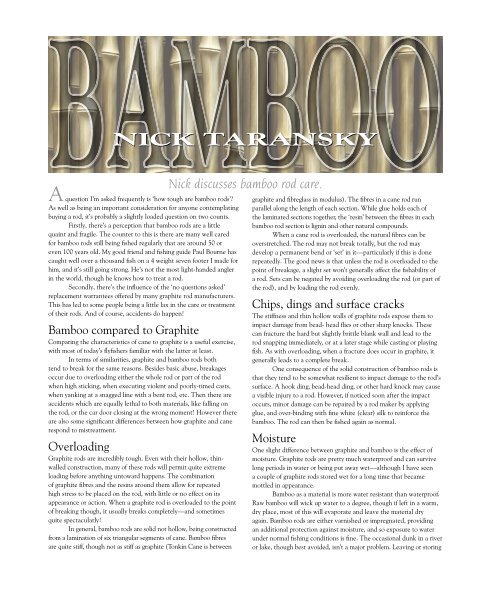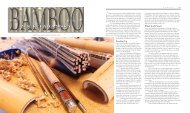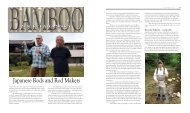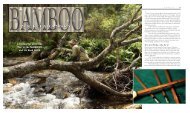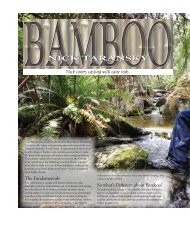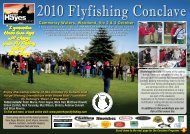Issue #7 - NA Taransky Bamboo Rods
Issue #7 - NA Taransky Bamboo Rods
Issue #7 - NA Taransky Bamboo Rods
- No tags were found...
Create successful ePaper yourself
Turn your PDF publications into a flip-book with our unique Google optimized e-Paper software.
B A M B O O 119a rod wet is the biggest concern. Water can find its way thoughminor chips or scratches in the finish, soak into the bamboo,and eventually rot and weaken the material. Thus, cane rodsshould be wiped dry after use. When stored, the cap should beleft off the rod tube for a few days. Even better, hang the rodsomewhere safe in its cloth bag.FerrulesGraphite rods are fitted with either integrated sleeve ferrules,or spigot ferrules. Advice on assembling these connections isgenerally to twist the rod sections into alignment as the jointis pushed together. This works because the ferrule is part ofthe rod, there is some taper in the fit, and also some inherentflexibility in the graphite ferrule itself.Modern bamboo rods are usually fitted with nickelsilver ferrules, while many older rods have brass ferrules. Theferrules are attached to the rod sections by fitting and glueingthe bamboo inside the ferrule. At the transition point thereare usually fingers or ‘tabs’ on the ferrule, which are tapered,and bound over. This allows a short area of flexibility betweenthe bamboo and the stiff metal ferrules. Nickel silver ferrulesare parallel in fit (as opposed to tapered graphite ferrules) andengage for the full length of the slide. Twisting a cane rod ferruleinto place is not a good idea, because it causes stress to theshort section of bamboo between where the rod is held and theconnection to the ferrule. It also places unneeded pressure onthe glue between the bamboo and nickel silver.The simplest way to assemble a bamboo rod is to line upthe rod sections first with your fingers as close as practical to theferrules, and then slide the ferrules together smoothly. Whenpulling the rod apart, a straight pull is the way to go, but thistime with your hands further apart—this encourages a straightpull on the rod.
120 F L Y F I S H E RNickel silver is a self-lubricating material, so keeping theferrules simply clean and dry is best. The male can be wiped with acloth, and the female cleaned with a cotton bud or barrel of clothtwisted in.Warranties and Spare SectionsAs mentioned previously, many graphite manufacturers offer verygenerous warranties. Without going into detailed economic analysis,it’s obvious that the initial purchase price is partly inflated to factorin likely replacement of a section or more over the life of the rod (orangler!)The large amount of work in making a bamboo rod precludesthe possibility of bamboo rodmakers offering unlimited warranties.This is offset by the traditional practice of making cane rods with aspare tip. As well as providing insurance against the breakage of onetip, it also permits sharing wear across two tips.FACT FILEBAMBOO ROD CARE TIPSBelow are some tips I provide on a care sheet to people buying a cane rod or asking advice—these summarise most of the points I’ve covered above. Many of these tips area good starting point for graphite rod care as well. I am also in the process of putting together a short video on rod care for YouTube.GENERALMajor threats to a bamboo rod include:• Severe over-bending, or placing a sharp bend over a small section of the rod.• Striking the rod against rocks, branches or with bead-head fl ies, causing dings orchips in the bamboo.• Sustained contact with moisture (caused for example by storing a wet rod in asealed tube after fi shing).Keep these points in mind when using and storing your rod. The following are somespecific instructions which will minimise the chances of damaging your rod.STORAGE• When not in use, the rod should be kept in a cool, dry place. As mentioned earlier,before placing the rod back in its tube after fi shing, wipe off any excess moisture.After returning from your trip, either hang the rod in its bag in a safe place usingthe loop of the bag, or leave the cap off the tube for a few days to allow moisture toleave the tube. Never store the rod out of its tube, leaning against a wall.• Never leave the rod in the sun in the back of a car.• While placing the whole bag and rod sections back in the tube, form a ringaround the top of the tube with the thumb and forefi nger of one hand (slightlysmaller than the opening). This protects the rod and guides from catching onthe lip of the tube as the bag is inserted. Never try to force the rod back into thebag and tube.• If the rod has ferrule plugs, when not in use, keep the plugs in the ferrules to keepdirt and moisture out.• Never store the rod assembled. The ferrules may fuse and get stuck forever!ASSEMBLING THE ROD• Do not lubricate the ferrule. Give the male ferrule a wipe with a clean cloth (or yourshirt) before assembly.• Align the guides from the two sections before seating the ferrule. Never assemblethe rod with the ferrules misaligned and then twist it into place. Never force theferrules together if they feel too tight. Take the rod apart and clean out the femaleferrule with a cotton bud or barrel of tissue or cloth.• When seating the ferrules, keep your hands as close together as practical (adjacentto the ferrules) to avoid placing the rod under undue pressure.• When setting up, avoid bending the tip when pulling line through. Pull the linestraight out from the tip. Never hold the rod near the tip and pull line out at anangle.TAKING THE ROD APART• When taking the rod apart, hold the butt section low down with your right hand(if right handed) with your hand close to you, and hold the tip section with yourleft hand just above the ferrule, keeping your arm out relatively straight. This willpromote a straight pull on the rod.• Never use the guides to brace your grip on the rod while assembling ordisassembling the rod.• Remember the basic rule ‘together-together, apart-apart’ (putting the rodtogether – hands together; pulling the rod apart – hands apart).FISHING• If your rod is a two tip rod, alternate the tips on fishing trips.• While playing a fi sh, try to turn the rod over periodically to balance the pressure onthe rod.• Avoid ‘high sticking’ the rod while playing fish. High sticking is pointing the rodstraight up, or even back behind you, when exerting pressure on the fish. This canover-stress the rod, leading to breakage or a ‘set’ in the rod. Because of the fullerloading nature of bamboo over stiffer materials, a more effective way to tire andplay fi sh is to keep the rod lower, at 45 degrees.• When landing a fi sh, try to avoid high sticking by holding the rod back behind youwith the butt up and the tip down a little. Use a net, or grasp the leader for the finalphase of landing the fi sh.• Sometimes the rod may show a slight bend after playing a large fish. Give the roda wiggle as soon as you notice this and it should straighten out. Keeping (andstoring) the rod straight will reduce the chance of the rod taking a permanent set.• Never use the rod to pull a fl y out of a snag or bush. Take some slack line in frontof the tip, and carefully pull the fl y free (or break the tippet) by hand.• When picking the line off the water to cast, lift off smoothly before accelerating intothe casting stroke, rather than violently ripping into the backcast. This results in abetter cast and avoids overloading the rod.• When storing the fl y while fi shing, if the rod is not fitted with a hook keeper, passthe leader under the reel foot, and hook the fly on a convenient guide on the rod.Keep the line tight enough to hold the fl y in place, but never so tight that the rod iskept bent.• If your rod is accidentally damaged in the course of fishing, stop fishing with itimmediately to avoid further damage. A small crack in the rod can sometimes berepaired without the requirement to replace the entire section.Even with care, bamboo rods can eventually take a set (usually in the tip section, ina downward direction). This does not affect the fishing properties of the rod, and caneven be seen as a sign of character!<strong>Bamboo</strong> rod maker Nick <strong>Taransky</strong> lives in Queanbeyan, near the streams of the Monaro and Snowy Mountains.Visit www.taranskybamboo.com.au


